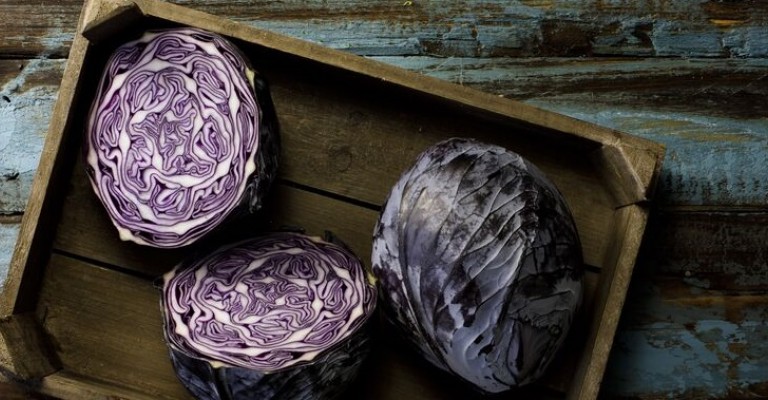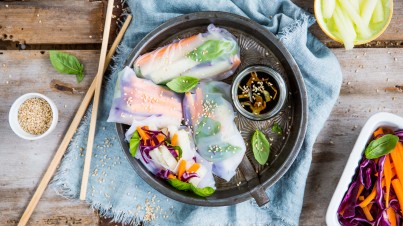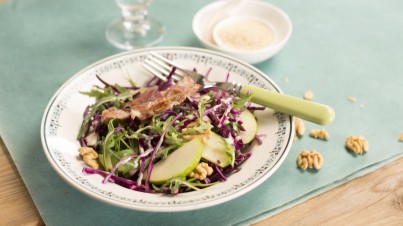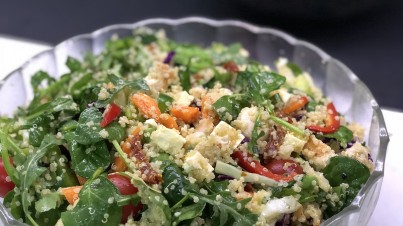Red or purple cabbage is a member of the Brassica family. Cabbages are relatives of both broccoli and cauliflower. Interchangeable with green cabbage, red cabbage has the same compacted leaves, similar taste, and shape – but with a distinctive red/purple hue. Water-soluble pigments called anthocyanins produce distinctive (and delicious) magenta leaves.
How to prepare
A whole cabbage can be intimidating unless you know how to chop it! Follow these steps to tackle your cabbage trepidation.
- Remove the outer leaves, tearing off the blemished, limp, and loose outer shell. Wash the cabbage under running water, working out any grit.
- Quarter the cabbage. Place it on a cutting board with the core facing down. Using a large and sharp knife, slice the cabbage downward, straight through the core. Place each half flat side down and cut in half again – starting at the top and moving down through the core. Now you have four manageable quarters.
- Remove the core. Place each quarter on the chopping board – cut side down – and slice out the core at an angle. (You can use the core fresh or cooked, though the texture is different to the leaves). If you want to grill or bake big chunks of cabbage – use them as is. If you want slaw, kraut, soup, or any dish with shredded cabbage – continue on to the next step.
- With a flat side against the chopping board, slice the cabbage vertically or horizontally (depending on how long you want your strands). Break apart any segments that hold together. Perfect!
Buyer's and storage guide
Look for heads that are firm, dense, and heavy for their size. Avoid soft or spongy feeling flesh. Generally, larger heads of cabbage have a milder flavour. The cabbage should have a dark purple to deep red colour, with a healthy lustre. Look for blemish-free leaves. On an old cabbage, the outer leaves will start to shrivel and shrink. They should be crisp and tightly pressed around the stem. If buying a cut portion, ensure the internal ribbing is creamy white.
Storing
Keep your cabbage whole while storing. Store whole heads in your fridge crisper in a perforated plastic bag. They can last up to 2-3 weeks. Wrap cut portions in plastic/airtight wrap. Store in the crisper and use within 3-4 days. If you don’t think you’ll get through all the cabbage while it’s fresh, freeze it or look for some pickled cabbage recipes!
Freezing Cabbage
- Wash and slice or shred your cabbage.
- Blanche the cabbage. Bring a pot of water to a boil (don’t salt the water or cabbage) and drop the cabbage in. 1-2 minutes for shredded cabbage; 2-3 minutes for larger slices.
- Drain and immediately bathe in a bowl of ice water.
- Dry the cabbage. This is important! Use kitchen towel or spread it out and wait for it to dry.
- Flash Freeze the cabbage – once it’s dry, spread it out on a baking sheet and freeze for around 7 hours, uncovered.
- Once it’s frozen, store it in portion-sized airtight containers for up to 9 months
Serving
Cabbage is wonderfully versatile. It's enjoyed cooked, pickled, fermented, and raw across many cuisines. Green and red cabbage can be interchangeable, though the red can stain other ingredients.
Cooked
To retain the vibrant colour of red cabbage when cooking, add vinegar, lemon juice, or acidic fruit to the pot. Cabbage can be cooked into stews, soups, stir-fried, and more. Here are some ideas!
- Red Cabbage Steak - a trending, festive veggie dish, with a sweet sauce.
- South African style Chakala. A spicy, tangy veggie relish, or side salad – serve with bread, stews, and bbq fare.
- Healthy Red Cabbage Soup - low in calories, high in fibre, packed full of vitamins, and an amazing colour.
Pickled
Pickled and fermented cabbage has long been prized for its healthful qualities. When cabbage is sprinkled with salt, juices are drawn out as the cell walls of the leaves collapse, These naturally ferment, forming the lactic acid that produces the familiar sour flavor of sauerkraut and kimchi. Making your own is easier than expected! Mixing in reb cabbage to these recipes offers an extra pop of colour.
Raw
Thin slivers of raw red cabbage offer great crunch, texture, and good nutritional properties to slaws and salads. Anthocyanins (which creates the beautiful colour) have antioxidant properties and as a result, there’s much research evaluating just how these compounds benefit our health. Here are some recipes for raw red cabbage.



